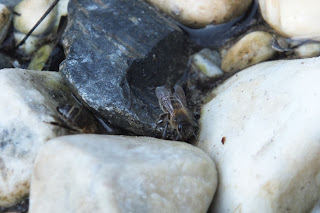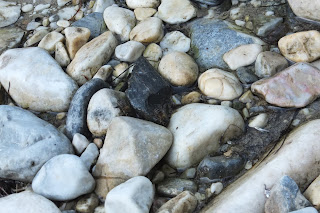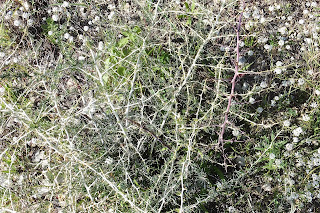Sunday 22 January 2017
Sweet Violets
Proper, sweet-smelling violets, Viola odorata, in the borders at San Juan Capistrano in Nerja. Though not on the Calle las Violetas.
Candiles, Andalusian pipevine
Aristolochia baetica, called locally candiles or candilillos, is a very distinctive scrambling vine with the typically weird flowers of the genus. Baetica was a province of the Roman empire that roughly corresponds with modern day Andalusia.
The name Aristolochia probably came from the Greek for "best childbirth", Aristolochia clematitis having the name Birthwort in English. Though many members of the genus have been used in medicine in both Europe and Asia they have been found in recent years to have a toxicity to the kidneys and tendency to cause cancer that makes them unusable. This toxicity is due to alkaloids such as aristolochic acid, an unusual nitro-substituted alkaloid.
The name Aristolochia probably came from the Greek for "best childbirth", Aristolochia clematitis having the name Birthwort in English. Though many members of the genus have been used in medicine in both Europe and Asia they have been found in recent years to have a toxicity to the kidneys and tendency to cause cancer that makes them unusable. This toxicity is due to alkaloids such as aristolochic acid, an unusual nitro-substituted alkaloid.
The first plants were scrambling over a thorny shrub by the roadside on the way eastwards from Maro.
This is a pipevine fruit on the same plant.
Attached to the shrub was what appeared to be a small wasp nest.
By the Torre de Maro I encountered another colour form of this species. The true colour is a little darker than it seems in these pictures, due to the camera not coping with the strong sun. The pale parts were a dark beige. The dark purple forms were growing within a few paces of these.
Bees drinking water
Coming down the Rio Chillar a few hours before sunset I saw dozens of bees drinking from the stream. They didn't seem too bothered by my company so I got a few good shots. I am pretty sure this is the Iberian variety of the honeybee, Apis mellifera ssp. iberica.
Not a Scarlet Pimpernel
Well, it is a scarlet pimpernel but it is not scarlet. This is a blue variety of Anagallis arvensis, Both this and the brick-red variety are found in Andalucia but this was the most common where I have been. It is called murajes in Spain (a name of unknown origin also used of chickweed, Stellaria media, which has similar leaves). The Basque name is amorrubedarr, meaning "rabies herb".
There is another blue pimpernel in Spain, A. monelli, but that has thin, long leaves and larger flowers. That one goes by the glorious Spanish name of Centaurea real, the Royal Centaury,
There is another blue pimpernel in Spain, A. monelli, but that has thin, long leaves and larger flowers. That one goes by the glorious Spanish name of Centaurea real, the Royal Centaury,
Horrid Asparagus
This is the plant from which I got the most scratches and stabbings while rambling about Nerja, Not as bad as Sarsaparilla but more abundant on the tracks. There are three species of wild asparagus (espárragos trigueros or espárragos silvestres) in the area: Asparagus acutifolius, A. albus and A. horridus. I am pretty sure that these photos are an individual of A. albus. The true leaves have transformed into thorns, in this case the cladodes (stems converted into leaf look-alikes) do not end in a spine and are held in bunches.
All of these wild asparagus provide young shoots more prized than the cultivated asparagus. Cut before they develop thorns, obviously. The taste is very much like the cultivated asparagus but stronger. The roots are succulent and tender and juicy and very tasty too. They are not often collected except to dry for medicinal use. None of the plants I encountered were in flower or berry but several had new shoots coming up, like this one.
All of these wild asparagus provide young shoots more prized than the cultivated asparagus. Cut before they develop thorns, obviously. The taste is very much like the cultivated asparagus but stronger. The roots are succulent and tender and juicy and very tasty too. They are not often collected except to dry for medicinal use. None of the plants I encountered were in flower or berry but several had new shoots coming up, like this one.
The shoot in front is out of focus but the less obvious one directly behind shows the classic asparagus shape.
Here the classic asparagus shoot on the left and an older but still purple and soft shoot on the right.
Can you spot the good bit?
Waves and Clouds
Unfortunately the camera seemed to pick a low resolution and I didn't think to try to change it. All of these photos are done in flower portrait mode as well.
This first shot was at the beach where the Honey River (Rio de Miel) reaches the sea, just eastwards of Nerja.
This first shot was at the beach where the Honey River (Rio de Miel) reaches the sea, just eastwards of Nerja.
I seem to have taken 12 photos to get that one, the next shows why there is a cloud of spray in the first one.
Here are some sea and cloud photos from various parts of the coast.
This last photo shows various stages in formation of the distinctive lenticular clouds, often seen above the Andalucian coast. When more perfectly formed these are often claimed to be UFOs. Apparently the south coast is the most common place in the UK for UFO reports of the flying saucer variety.
Nerja landscapes
I just got back from Nerja on the coast of Malaga province and have a few photos of plants to put on here. First though I thought I would put up the landscapes I took. Mainly because they will need less thinking about the descriptions.
The first three are all from a little bay by the side of Torre de Maro.
The first three are all from a little bay by the side of Torre de Maro.
The next six are all from the trail that leads above the Cuevas de Nerja. This was on the one morning with a bit of cloud and strong winds.
Just east of Torrox on the coast road to Nerja is this little roadside shrine, according to Google Maps it is the Roca Virgen del Mar y Cristo del Mar. It is covered with flowers, drink and other offerings with plaques of the names of the deceased.
Subscribe to:
Posts (Atom)






















































